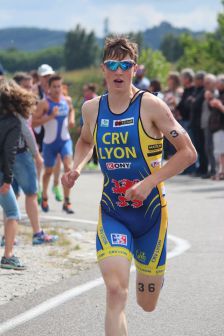Have you ever jumped off the bike feeling fresh, only to get 300 metres and find yourself still doing the “Froome hobble”? Fear not with our beginner’s guide to bike-to-run tips
Chris Froome turned stage 12 of the Tour de France into a duathlon last week. “I was with Richie Porte and Bauke Mollema and all three of us went into the back of the motorbike,” he told French TV.
His frame had broken. But his two competitors had managed to cycle on. Amidst the chaos, Froome remained astonishingly calm.
“I told myself, ‘I don’t have a bike and my car is five minutes behind with another bike – it’s too far away, I’m going to run a bit’.”
And that’s what he did.
Putting the reported breaking of the rules aside, hats off. “Well, he’s from Kenya, you expect him to be good at that,” Sky teammate Geraint Thomas later quipped.
Froome’s run was, of course, more of a hobble (He’d made the rookie duathlete/triathlete’s mistake and forgotten his running shoes).
Not many of my run-bike-runs or swim-bike-runs have involved a Mont Ventoux climb, 11 previous days of 200km+ cycling and cashing into a motorbike. But watching the great man’s gait as he fleed uphill towards the finish line stirred memories of some of my races.
(You know: the early ones you do, where you buy the photograph of you running in a tri suit to prove to yourself that you’d actually done it. Or is that just me?)
Anyway, rather than relax, ease into my stride and eat up the 5km or 10km in front of me, my form would more closely resemble the jog my rickets-ridden grandfather would break into around the snooker table when he was onto a decent break.
So, what can you do about it?
Brick sessions are a great place to start. These workouts involve more than discipline, helping your body to “transition from one sport to the next”, says Dan Holmes, a personal trainer and British Triathlon Level 2 Coach and founder of ProfilePT.
But remember: every session is not a duathlon or triathlon. “You don’t need to run after every bike session because that will give you very sore legs,” adds Sportstest’s Dr Garry Palmer
For those starting out, a bike-run session once every week or two weeks is about right, say the experts. Indeed, in training for triathlon, you are not training for three sports. “That will probably mean you only will do five or six training sessions per week; not 15 or 20,” says Palmer.

So, a couple of miles after a Saturday morning club ride or following a turbo session, for example, will help improve how your body responds in transitioning from bike to run.
Let’s not forget that you are moving from a crouched position, where your hamstrings and back are over-stretched, your hip flexors are shortened and your sciatic nerve is under strain. Even Jane Fonda would have trouble unwinding herself from that mess.
It’s therefore important to build “prehab conditioning” into your training, says Holmes. This includes all the things that it’s so easy to ignore. (I often find myself wondering whether a pilates session midweek is worthwhile when I could be swimming, cycling or running for an hour instead).
But it’s a fact: stretching, foam rolling, mobility, balance, and core strength will help your body to move in a biomechanically sound manner, and allow you to run more economically. That’ll put you in good stead for race day.
Once the adrenaline kicks in and you’ve got those brick sessions under your belt, it’s easy to get carried away. Running off the bike and straight into your 10km PB pace is a sure-fire way to positive splits (where your times get progressively slower).
During the bike and run you need to know your own capability, says Holmes. “Spikes in effort on the bike can kill a fast run,” he explains.
This is where you can embrace some of the technology available, such as heart rate monitors and GPS watches to keep you on pace, both in the race and during training.
(This brings to mind my own example of how not to do it. One of the last long brick sessions I completed whilst training for the Celtman ironman involved a three-hour bike and two-hour hill run. I felt great on the bike so ramped it up. An hour into the run I was struggling; Froome would have passed me in his SPDs. I ended lying on the floor with cramp).
Holmes knowingly adds: “Aim to ride consistently at a level you know can maintain for the full distance, leaving enough in the tank to execute a good run.” Oh, and don’t forget to change from your SPDs to your racing flats.
David Burrows is a freelance food and drink writer
Twitter: @envirobuzz